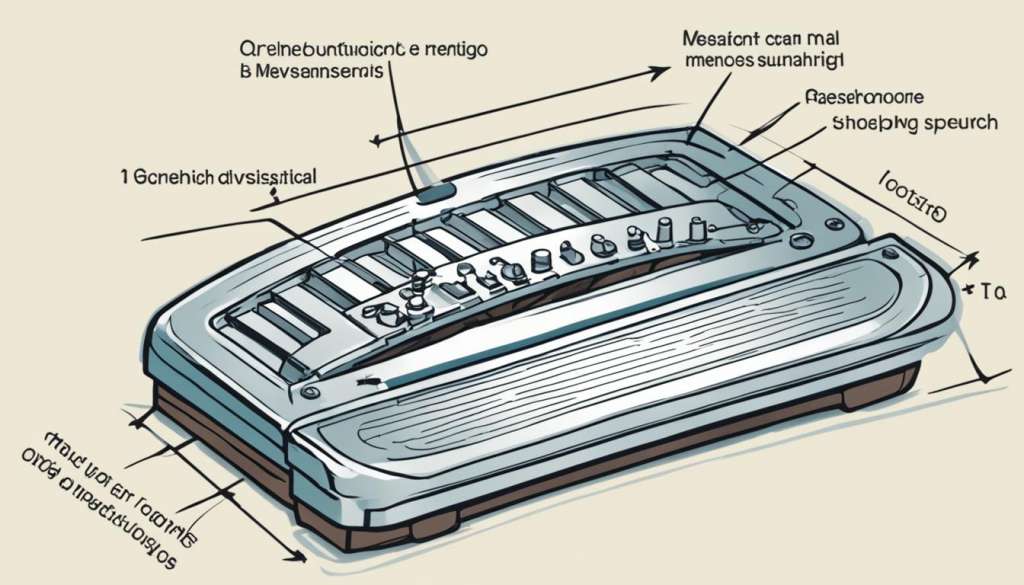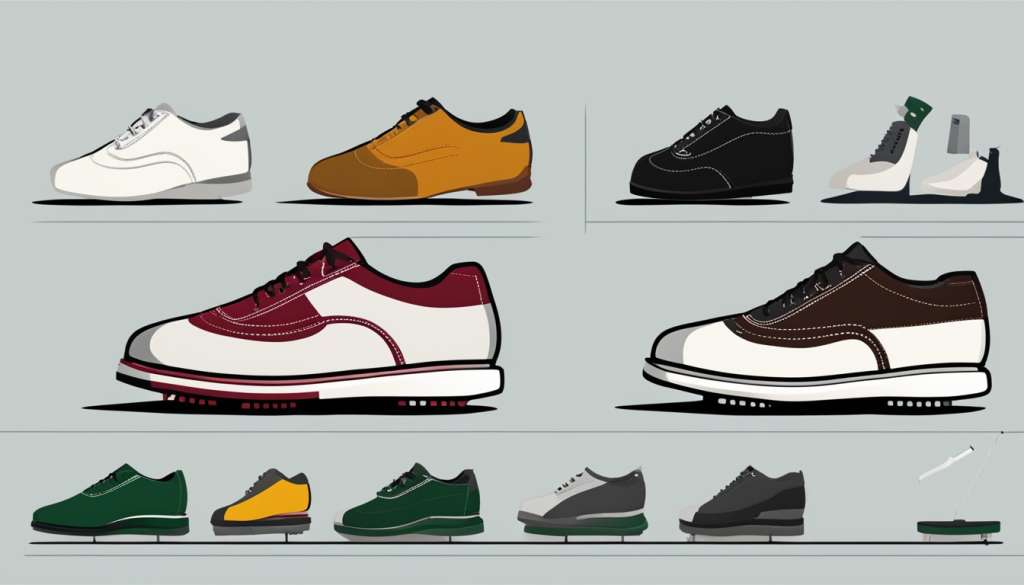Wearing the right golf shoes is key to better performance and comfort. The right size can increase your swing force by up to 21%. Sadly, over 70% of golfers wear shoes that don’t fit well, hurting their game and foot health.
This guide will walk you through golf shoe sizing. You’ll learn how to measure your feet and spot fit issues. It will help you pick the perfect shoes for your foot shape.
Whether you’re a pro or play golf on weekends, knowing how to fit golf shoes is crucial. Let’s explore how to find the best shoes for you. This ensures comfort and performance with every step on the green.
Understanding the Importance of Proper Golf Shoe Fit
Getting the right golf shoe size is key to your game. It impacts your comfort, how well you play, and your overall experience. Let’s see why finding the right fit is a must for every golfer.
Impact on Performance and Comfort
How well your golf shoes fit affects your performance. Shoes that fit well reduce slipping and friction. This lets you focus on your swing.
Studies show that the right size can increase your swing force by up to 21%. This means longer drives and more accurate shots.
Preventing Blisters and Foot Fatigue
Wearing shoes that don’t fit right can cause blisters and foot pain. But, shoes that fit well reduce rubbing and pressure. This is crucial for long rounds or playing over several days.
Choosing the right size means you’ll enjoy your time on the course without discomfort.
Enhancing Stability During Your Swing
Your golf swing starts with a solid foundation. The right fit in your shoes helps with this. Shoes that are too loose can make your feet slide, throwing off your balance.
On the other hand, shoes that are too tight can limit how much your feet move. The right fit gives you the balance you need for a good swing.
| Fit Issue | Impact on Swing |
|---|---|
| Too Loose | Foot slides, loss of balance |
| Too Tight | Restricted movement, discomfort |
| Proper Fit | Optimal stability, natural motion |
Investing time in finding the right golf shoe size improves your performance. It also reduces foot fatigue and boosts stability. Your feet will be happy, and so will your golf game.
Measuring Your Feet for Golf Shoes
Getting your foot measured right is key to finding the best golf shoes. We’ll go over the steps to make sure you get a fit that helps you play better.
Using a Brannock Device
A Brannock Device is the top choice for measuring your feet. It gives you exact measurements of your foot length, width, and arch length. Here’s how to use it:
- Place your foot on the device
- Align your heel with the back
- Read the length measurement
- Check the width indicator
- Measure your arch length

The Importance of Measuring Both Feet
Always measure both feet, as they’re often a bit different. Use the bigger foot’s measurements when picking golf shoes. This makes sure both feet fit well.
Considering Arch Length and Foot Width
Arch length and foot width are key for comfy golf shoes. The arch length makes sure your foot flexes right during your swing. Foot width affects how well the shoe fits and stays stable.
| Measurement | Importance | Impact on Golf Performance |
|---|---|---|
| Foot Length | Determines overall shoe size | Prevents toe cramping and heel slippage |
| Arch Length | Aligns foot flex point with shoe | Improves balance and power transfer |
| Foot Width | Ensures proper lateral fit | Enhances stability during swing |
Measure your feet at the end of the day when they’re a bit swollen. This way, your golf shoes will fit well even after playing for hours.
Golf Shoe Sizing and Fit Guide
Finding the right golf shoes can really improve your game. A good fit means you play better and feel comfy on the course. Let’s explore how to pick the right size and fit for your golf shoes.
Golf shoe sizes can be tricky. They’re not always the same as your regular shoe size. That’s why it’s smart to use a golf shoe size chart when shopping. These charts help you match your foot measurements to the right size.
For men’s golf shoes, sizes usually run from US 4 to 17. Women’s golf shoes typically come in sizes US 3 to 13. But remember, these numbers can change depending on the brand you choose.
| Shoe Type | Size Range (US) | Width Options |
|---|---|---|
| Men’s Golf Shoes | 4 – 17 | N, M, W, XW |
| Women’s Golf Shoes | 3 – 13 | N, M, W, XW |
Width options are just as important as length. You’ll often see choices like narrow (N), medium (M), wide (W), and extra wide (XW). Pick the width that gives you a snug but comfy fit.
Don’t be afraid to try on shoes from different brands. Sizes can vary, so what fits in one brand might not work in another. Take your time to find the perfect pair for your feet.
Key Indicators of a Well-Fitted Golf Shoe
Finding the right fit in golf shoes is key for doing your best on the course. A good fit means more comfort, better stability, and improved swing. Let’s look at what makes a golf shoe fit just right.
The “Rule of Thumb” for Proper Fit
When you try on golf shoes, make sure there’s half an inch of space between your longest toe and the shoe’s end. This space lets your foot move freely during play and keeps you comfy. Make sure you can wiggle your toes a bit.
Flex Point Alignment
Getting the flex point right is crucial for your foot’s natural movement. The shoe’s flex point should line up with where your foot bends. Stand on your toes to check. The shoe should bend where your foot does.
Heel and Midfoot Snugness
A good heel fit stops your shoe from slipping during your swing. Your heel should feel secure but not too tight. The midfoot should also be snug but not press too hard. A good fit here means you’ll stay stable all game long.
| Fit Area | Ideal Feel | Importance |
|---|---|---|
| Toe Box | Roomy with slight wiggle room | Prevents blisters and allows natural toe splay |
| Flex Point | Aligns with foot’s natural bend | Ensures proper foot mechanics during swing |
| Heel | Snug without slipping | Provides stability and prevents heel lift |
| Midfoot | Secure but not tight | Offers support and enhances overall fit |
Test your golf shoes by swinging like you’re on the course. A well-fitting shoe will keep you comfy and supported. This lets you focus on your game, not your feet.
Understanding Golf Shoe Width Options
Golf shoe width is key to your comfort and how well you play. Many golfers don’t know they might need narrow or wide golf shoes. In fact, about 40% of people wear shoes that are too tight or too loose.
Brands like FootJoy offer a range of widths to fit different foot shapes. They have options from N (narrow) to XW (extra wide) for men, and N to W for women. This means you can easily find the right fit for your feet.

How do you know if your golf shoes are the wrong width? Look for these signs:
- Eyelets too close together or far apart
- Excessive bunching around the foot
- Stretching or tightness around the toes
If your golf shoes are too tight, trying a wider size might help. This can fix the issue without losing the good fit.
| Width | Description | Ideal For |
|---|---|---|
| Narrow (N) | Snug fit for slim feet | Golfers with narrow heels and forefoot |
| Medium (M) | Standard width for most feet | Average foot width |
| Wide (W) | Extra room in forefoot | Broad feet or those needing more space |
| Extra Wide (XW) | Maximum width available | Very wide feet or specific foot conditions |
Finding the right golf shoe width can make a big difference in your comfort and how steady you feel while playing. Don’t be afraid to try different widths to find what works best for you.
The Role of Arch Shape in Golf Shoe Selection
Your arch type is key in picking the right golf shoes. Knowing your foot’s shape ensures you get the best fit for comfort and performance.
Identifying Your Arch Type
To figure out your arch type, try the “wet test.” Stand on a flat surface with wet feet and look at your footprint. A full imprint means you have low arches. A thin connection suggests high arches. A normal arch leaves a distinct curve inside the foot.
Choosing Shoes for Different Arch Types
If you have low arches, choose golf shoes with strong midsole stability to stop overpronation. High arch golf shoes should fit wider and have more room. If you have normal arches, you can pick from a variety of shoes.
Impact of Arch Support on Comfort and Performance
Good arch support in golf shoes makes you more comfortable and performs better. It spreads pressure evenly on your foot, reducing fatigue and improving swing stability. Remember, your arch shape might change with age, becoming flatter. So, check your needs often.
| Arch Type | Recommended Features | Benefits |
|---|---|---|
| Low Arch | Stability features, firm midsole | Prevents overpronation, improves balance |
| High Arch | Wider fit, cushioning | Accommodates foot shape, absorbs shock |
| Normal Arch | Balanced support and flexibility | Versatile performance, comfort for most activities |
Common Fitting Issues and How to Address Them
Golf shoe fitting problems can affect your game and comfort. Let’s look at common issues and solutions to help you find the right fit.
Pronation is a common issue for golfers. If your shoes show a lot of wear on the inside, you might overpronate. Look for golf shoes with strong midsole support, like the FootJoy Premiere Series or Pro|SL models. These shoes help keep your feet stable during your swing.
Plantar fasciitis is another issue that can hurt golfers. If you have heel pain, see a doctor for shoe advice. They might recommend shoes with extra cushioning or arch support to ease the pain.
Custom orthotics can be a big help for ongoing foot problems. These inserts fit your feet perfectly and can fix issues like pronation and plantar fasciitis. Many golf shoes let you remove the insoles, making it easy to use custom orthotics.
Watch for signs of a bad fit:
- Excessive wear in the heel area
- Blisters or hot spots on your feet
- Feeling of toes being cramped or rubbing against the shoe’s front
- Feeling like your foot slides inside the shoe during your swing
If you see any of these signs, it’s time to check your golf shoe fit again. Remember, the right fit can make you more comfortable, stable, and improve your game.
Differences in Men’s and Women’s Golf Shoe Sizing
Golf shoe sizing is different for men and women, affecting how comfortable and how well you play. It’s key to understand these differences to find the right fit.
Gender-Specific Fit Considerations
Women’s golf shoes have narrower heel cups and toe boxes than men’s shoes. This design fits the average female foot better, offering support and reducing slipping during swings. Ladies golf shoes focus on a snug heel and midfoot while still letting the toes move.
Size Conversion Between Men’s and Women’s Shoes
Converting golf shoe sizes can be tricky. Women’s sizes are usually 1 to 1.5 sizes bigger than men’s. For instance, a women’s size 8 is about like a men’s size 6.5 or 7. Some brands have unisex sizes, making it easier for those in between sizes.
| Women’s Size | Men’s Size |
|---|---|
| 7 | 5.5 |
| 8 | 6.5 |
| 9 | 7.5 |
Addressing Unique Fitting Needs for Female Golfers
Female golfers often need deeper toe boxes for comfort, even if it means less style. Women’s golf shoes are made with these needs in mind, offering various width options. When shopping, try half a size larger or wider than your usual dress shoe size for a better fit and comfort during long games.
Conclusion
Getting the right size in golf shoes is key for comfort and doing well on the course. It’s important to measure your feet right and choose the best fit. This can greatly improve your game.
When looking for golf shoes, think about the width and arch support they offer. These features help prevent blisters and keep your feet from getting tired. Also, remember that different brands fit differently, so trying them on is crucial to find what works best for you.
Wearing well-fitting golf shoes can make your swings more stable and help you play better. By focusing on the right size and addressing any foot issues, you’re setting yourself up for success. Your feet will be happy, and you might even see your scores go down!

